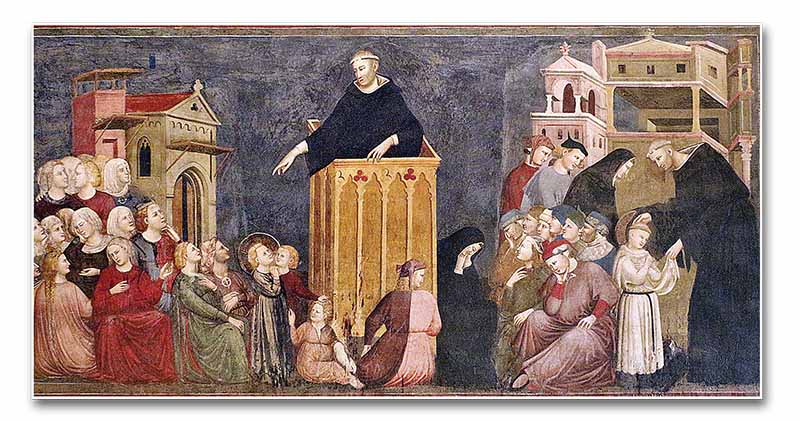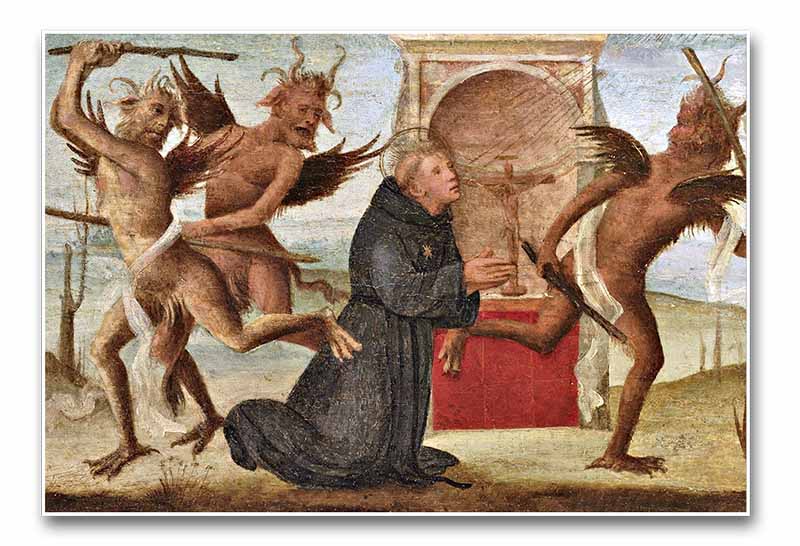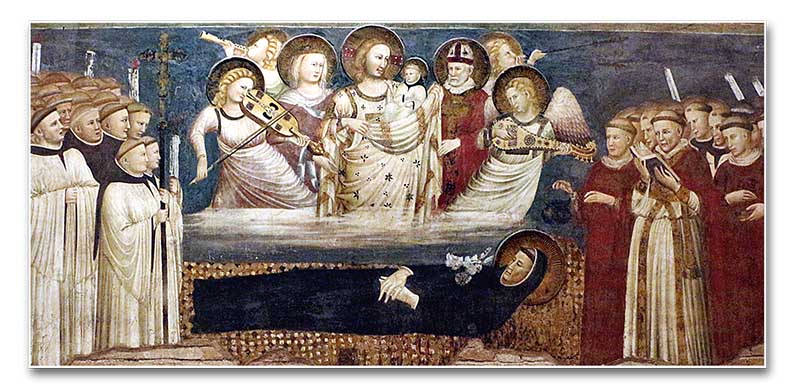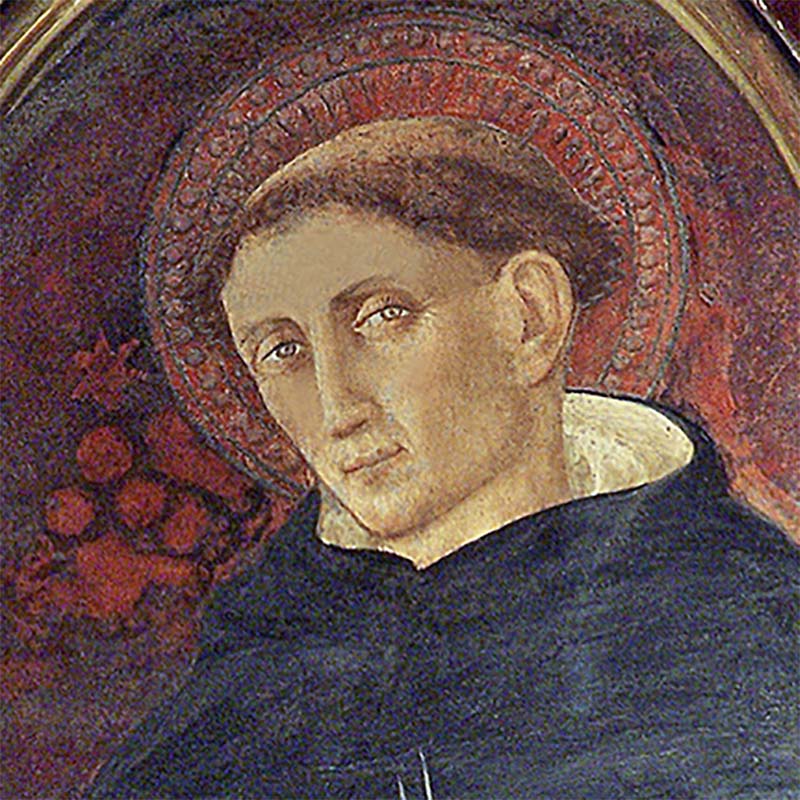His coming into the world marked by a miracle, this great Augustinian wonderworker became the advocate of the Church Suffering; he was like a brilliant star illuminating the Church Militant so as to finally shine in glory in the Church Triumphant.
It was Saturday night in the Augustinian hermitage of Valmanente, near Pesaro, in Italy. A young priest had just retired for his well-deserved repose, when he heard a scream:
— Nicholas! Man of God, look at me!
Startled, he turned in the direction of the cry and saw a figure that he could not manage to identify. It continued to speak:
— I am the soul of Friar Peregrino de Osimo, whom you knew, and I am being tormented in Purgatory, where I have come to purify myself of my faults.
Having thus introduced himself, the blessed soul asked him to celebrate a Mass for the dead to relieve him of the flames that consumed him. Fr. Nicholas replied that he was responsible for presiding over the conventual Eucharist that week, which would prevent him from celebrating Masses for the deceased.
At that, Friar Peregrino proceeded to show him a valley close to Pesaro, filled with a multitude of souls, of both sexes and of every age and condition, some from different religious orders, and asked if he was capable of rejecting the pleas of such a crowd.
The next morning, Fr. Nicholas related the vision to his superior, and obtained authorization to celebrate Requiem Masses throughout the week for those suffering souls. Moreover, he prayed for them day and night, with tears of compassion. After seven days, Friar Peregrino returned to thank him for his intercession, saying that he and a large number of his comrades in pain were now enjoying the beatific vision.
This is the origin of the seven days of Masses for the faithful departed of St. Nicholas Tolentino, the man who became known by the holy souls as he who “with the vessel of his merits and prayers cuts thought the seas of Purgatory.”1
In these brief lines, we will sketch some highlights of the singular life of this great wonderworker, of whom Pope Eugenius IV, who canonized him, said: “No Saint since the time of the Apostles surpasses St. Nicholas of Tolentino in the number and greatness of miracles.” 2
A man marked by miracles
Indeed, prodigy marked his life since his conception. His parents, after many years of marriage, were childless. His mother, Amada Gaidani, who was very devoted to St. Nicholas of Mira, promised that if she were freed of sterility, she would give the child that she conceived to the religious life, be it a boy or a girl.
The Saint himself, told a friend – the notary Berardo Apillaterra, what happened: “Having made the vow, they went to visit the Shrine of St. Nicholas, in Bari. Upon their return, I have been told that my mother conceived me.”3 Thus the miracle boy was born in 1242, in the small Castelo Sant’Angelo, modern-day Sant’Angelo in Pontano, and was given the name of his patron.
From a tender age, Nicholas fled from all that was worldly and frivolous and prayed with such recollection that he awakened admiration. At only seven, he started to fast three times a week and to eagerly welcome the poor into the family home. He would also retire to a nearby cave to devote himself to solitary prayer.
As he grew older, he attended Mass and served as an acolyte. Many years later, he revealed a childhood vision to a religious who cared for him during one of his many illnesses: “My son, it is a grievous thing that one loses childhood innocence and thus reaches old age. Even though I am the sinner that you see, when I was enjoying that innocent age, attending Mass in the church as usual, at the moment when the celebrant raised the Lord’s Body, according to the ritual, I clearly saw with my own eyes a handsome boy, marvellously attired, with a luminous face and a joyful gaze, who said to me: ‘The innocent and the just are united with Me.’”4

Son of St. Augustine
Highly intelligent, Nicholas attended the parish school of the Canons Regular of St. Augustine, and there he stood out for his seriousness and responsibility. He made rapid progress in his studies, and when he was yet an adolescent, he received minor orders, and was granted the position of a canon in the Collegiate Church of the Most Holy Saviour. A prestigious career lay open before him.
But such a life did not satisfy his heart’s desires, for he yearned to consecrate himself entirely to God. One day, as he listened to an Augustinian friar preach, he heard this New Testament passage: “If any one loves the world, love for the Father is not in him. […] The world passes away, and the lust of it; but he who does the will of God abides for ever” (1 Jn 2:15,17). These words struck his soul deeply and he requested the preacher admittance into his order.
With the blessing of his parents, who considered this decision to be the fulfilment of their promise, Nicholas was received as a son of St. Augustine at around 14 years of age. After completing his postulency, he was sent from Sant’Angelo to the neighbouring monastery of San Ginesio to begin the novitiate and study theology.
There he was given the task of almoner and proved outstanding for his generosity in distributing provisions to the poor and needy who came seeking aid at the convent doors. Once, as he placed his hands on the head of a sick boy, he said: “The good God will cure you.”5 The child was instantaneously healed.
Subtle wiles of the devil
In community life, he always considered himself the least of all. He carried out the most lowly and onerous tasks, cheerfully and without complaint, never losing his patience and always seeking to do the will of others. He conserved angelic purity; austere penances, fasts, and rough sackcloth were his arms against evil passions. He slept on the bare ground and used a rock as his pillow. He never ate meat, and on the days on which he did not fast, he limited himself to bread and unsalted, half-cooked vegetables. Having made long strides along the path of perfection, he made his solemn perpetual profession before turning eighteen.
A cousin of the Saint, superior of a convent whose rule and life were less rigid, proposed to transfer him there, alleging that despite his youth he was looking like a gaunt old man and would soon lose his health and become useless in the community.
Nicholas considered this proposal to be a subtle temptation of the devil who aimed to deviate him from the radical self-giving to which he felt called. Immediately, he went to the church and as he steeped himself in ardent prayer, a number of Angels appeared to him as boys dressed all in white, melodiously singing in chorus. They urged him to remain in the Order of Hermits of St. Augustine, repeating thrice: “It is in Tolentino that you shall establish yourself; remain there, be steadfast in your vocation and be certain that there you will find your salvation.”6
This vision filled him with consolation and consolidated him on the path he had undertaken.
Priest and, finally… Tolentino!
From San Ginesio, obedience led him, successively, to Recanati, Macerata, back to San Ginesio, and then to Cingoli and Valmanente – where the episode of Friar Peregrino occurred – among other places. In many cases, the provincials moved him from house to house so that his exact observance and the fragrance of his holiness might edify his brothers of vocation.
During his stay in Cingoli in 1269, he was ordained a priest by Bishop Benvenuto de Scotivoli, of Osimo. His devotion received an added impulse with the divine character of the priestly ministry. In sickness and in health, he celebrated Holy Mass daily with admirable piety, never without confessing beforehand, and not infrequently amid tears.
Both the living and the deceased benefitted greatly from the merits of the Holy Sacrifices that he celebrated, as testified by the large numbers of souls from Purgatory, who, as they took flight to Heaven, appeared to him with thanks for having liberated them from their purifying torments.
Finally, the day foreseen by the Angels arrived: Fr. Nicholas was sent to Tolentino! There he remained for 30 years, excelling, according to one of his biographers, “in four important points: Mass, Confessions, preaching, and visiting the poor and sick.”7
His person, his actions and his miracles marked the city by whose name he would be known across the centuries, converting and encouraging souls to grow in fervour to these days.

Frequent attacks of the malignant one
In monastic life, the devil has particular hatred for prayer. He uses every means permitted by God to hinder this holy activity, in which the religious receives the strength to persevere and to progress in the spiritual life.
In order to disrupt the habitual recollection of St. Nicholas, the evil one would emit terrible screams, or reproduce animal sounds such as the snorting of bulls, the roar of lions, the howling of wolves and the hissing of serpents. At other times, he seemed to be opening the roof, breaking the shingle tiles, smashing pictures or even knocking the house down. The Saint, however, remained impassive, without giving the least sign of fear of alarm.
Sometimes the attacks were more direct. One day, the spirit of darkness entered his cell under the form of a giant bird, and with the beating of its wings upset the lantern that lit his oratory, breaking it to pieces. St. Nicholas prayed, took the fragments, fitted them back together, and with a breath, set the lantern alight again, as if nothing had happened. The same was repeated on two other occasions.
It was not uncommon for the devil to beat him cruelly, leaving him half-dead, his body covered with wounds. He was found more than once in this state in the cloister, where the evil one had dragged him. He became permanently maimed on account of these dire combats.
Never succeeding to overpower him with this type of ploy, the father of lies resorted to harassing him with temptations and scruples: he suggested that the Saint’s penances did not please God, but were, instead, a burden to the community.
With his soul immersed in anguish, he saw Our Lord in a dream. To overcome his mistrust, Jesus reminded him of the miraculous proofs of love that He had given him throughout his life and assured him that his penances were pleasing to Him, revealing that the fear he was feeling was nothing “more than an artifice of satan and that your name has already been written in the book of life.”8
Thus, the devil was dealt yet another defeat!
A few “fioretti”, among hundreds…
It is not easy to choose which miracles, from among the 301 registered as authentic in the 371 testimonies of his canonization process9, to recount in such a brief article. We offer a few of the more significant ones, in the manner of fioretti.
Having taken seriously ill because of his austerities, Fr. Nicholas’ superiors ordered him to eat a little meat. Having done so, his health only worsened, reaching what appeared to be the point of death. But he appealed to the Blessed Virgin, and She appeared to him accompanied by St. Augustine and St. Monica. Our Lady consoled him saying that Jesus carried him in His Heart, and that his founder and his saintly mother looked upon him with favour. Then she counselled him to eat a bit of bread moistened in water, assuring him that it would be an excellent remedy for his sickness. As soon as he did so, he was cured. In this way, the Mother of God gave her stamp of approval to the Saint’s meagre diet…
This episode is the origin behind the blessing of St. Nicholas Bread, held on his feast day, which has restored health to many sick people. Among the most celebrated cases was that of the future king of Spain, Philip II, who was cured of a high fever at eight years of age after eating the “blessed rolls given to him by an Augustinian Father, Luís de Montoya, at that time the prior of the convent of Medina del Campo.”10
Wonderworker of charity, as the monastery almoner, he frequently distributed the bread that was meant for the friars to the poor. Once the prior caught him in the act, and asked him what he was carrying under his mantle. The Saint responded that they were flowers, and “lo, the pieces of bread that he was carrying were transformed into beautiful roses, in the middle of the month of December.”11
On another occasion, he went to request a donation from a simple family that possessed a quantity of flour sufficient only to meet their needs. With remarkable detachment, the lady of the house gave him some bread that was meant for her children. The Saint blessed the benefactress, saying; “May God, for love of the one who, despite her poverty, cheerfully gave this alms, multiply your store of flour.”12 From then on, the lady made her daily bread without the flour in the pantry ever diminishing.

A luminous star: sign of future glory
One year before departing for eternity, he saw, in a dream, a star of extraordinary brilliance rise in the sky of Saint’Angelo, his birthplace, and move toward Tolentino, coming to rest over the altar of the oratory where he celebrated daily Mass and said his prayers.
Intrigued, Fr. Nicholas consulted a brother of good reputation and learning about the significance of the occurrence, and received this reply: “Father, this star is undoubtedly a sign of your sanctity, and I am sure that it will finish its course where your body shall be buried.”13 The Saint protested this interpretation, but the facts prove how true it was: until his death, a luminous star accompanied him in plain sight of all.
In addition, during his last six months of earthly life, “the Angels descended every night to his cell to regale him with their melodies and to give him a foretaste of eternal glory.”14
Feeling that the moment of his departure was approaching, St. Nicholas received Viaticum and Extreme Unction with deep fervour and then gave himself over to lofty contemplation. On the day of his death, he embraced the relic of the Holy Cross and surrendered his innocent soul to God as he said: “In manus tuas, Domine, comendo spiritum meum – Father, into Thy hands I commend my spirit” (Lk 23:46). It was September 10, around the year 1310.
Fulfilling the forecast of the star, at the tomb where the incorrupt body of St. Nicholas of Tolentino lies, grace opens souls to Christ through his intercession, to this day, operating conversions and miracles with its heavenly light. ◊
Notes








Dear Sr. Juliane Campos
Thank you very much for writing such a high quality referenced article on St. Nicholas of Tolentino.
God bless you
Chris